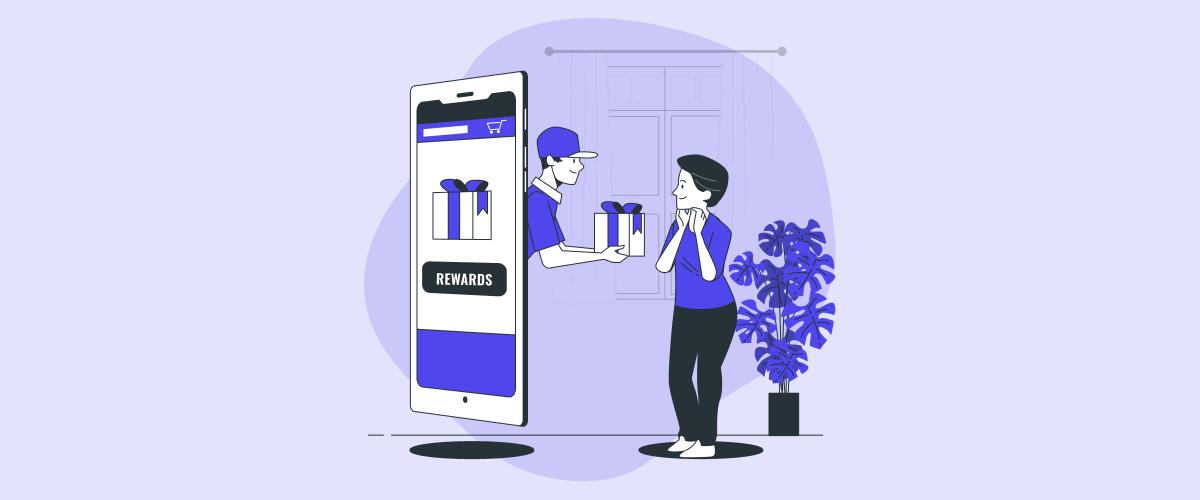78% of eCommerce stores fail because they treat customer loyalty programs as an afterthought.
You’ve got this amazing store. Ready with all products and discounts like confetti.
Yet something is off. Profit margin not hit right. That’s because discounts are like a fad diet. They work for a while, then you’re right back where you started.
They might bring in new customers, but they don’t guarantee customer loyalty.
So, you have to make your new and existing customers continuously engaged with your brand by implementing loyalty programs.
But you’ll ask:
- What are loyalty programs?
- Why do I need one?
- What are its types?
- How do I create it?
- Are there any examples?
- What are some creative loyalty program ideas?
- What are the best loyalty plugins in the market?
This blog will help you tick all the above checkboxes and help you build an effective loyalty system. Let’s get started.
Increase your ROI upto 20X with customized loyalty programs using WPLoyalty’s prebuilt loyalty campaigns easily.
What is a Customer Loyalty Program?
A customer loyalty program is a marketing initiative businesses implement to reward customers for repeat purchases, engagement, and other desired customer behaviors.
Loyalty programs are also called customer rewards programs or points and rewards programs because they reward both existing and acquired customers to be loyal to your brand.
The loyalty rewards can include loyalty points, percentage discounts, fixed discounts, free shipping, free products, exclusive access and more.
This is a way for businesses to grow revenue and reach more people.
Various Actions You Can Reward Your Customers Through Loyalty Programs
You can reward your customers for various actions with your brand. Here the most popular ones:
- Point for Purchases
- Signing up
- Referring new customers
- Writing product reviews
- On customer birthday
- Social shares (Twitter, Facebook, whatsapp, email)
- Daily login
- Achieving levels (Tiered loyalty system)
What are the Benefits of Loyalty Programs?
- Reduce Customer Acquisition Costs (CAC): It costs more to get a new customer than to keep an existing one. Loyal customers increase customer retention rates, which will directly reduce your CAC.
- Maximize Customer Lifetime Value (CLTV) = Higher Profits: Rewards programs directly increase CLTV by encouraging repeat purchases, larger order sizes, and longer-term engagement. This translates directly to higher profits.
- Drive Predictable Revenue Streams: A loyal customer base generates a more stable and predictable revenue stream. It allows you to better predict sales, inventory needs, and the overall business strategy.
- Customers do Free Marketing: Your loyal customers will be your best marketers. Chances are, they will speak more favorably about your business to their friends and family members, providing priceless word-of-mouth marketing free of charge.
- Reduce Abandoned Carts: Loyalty programs essentially reduce cart abandonment. Rewards for completing purchases or personalized reminders incentivize customers to finalize orders and recover lost revenue.
Related reading: Read more about the benefits of loyalty programs along with the examples.
5 Major Types of Customer Loyalty Programs?
While “loyalty program” is a broad term, several distinct models exist. Choosing the right one (or combining a few) depends on your business goals and target audience:
1. Points-Based Programs
- How They Work: Customers earn points with every purchase or action you define (like writing reviews or sharing on social media). What they can redeem those points for is usually a discount, free products, free shipping, etc.
- Ideal For: Small to medium-sized DTC eCommerce businesses.
- Example: 5 points for every $1 spent; 100 points = 10% discount, 500 points = a free product, 1000 points = exclusive access.
Related reading: Learn how to build a reward point system for customers using actionable ways.
2. Tiered-based Programs
- How They Work: Customers move up through different levels (e.g., Bronze, Silver, Gold) based on their spending or engagement. Each tier unlocks better rewards and exclusive perks.
- Ideal For: Ecommerce businesses selling higher-value products or services
- Example: Bronze: Free shipping; Silver (spend $500): 10% off; Gold (spend $1000): 15% off and early access to sales.
3. Referral Loyalty Programs
- How They Work: Customers get rewarded for referring new customers. Both the referrer and the referred friend often receive a bonus.
- Ideal For: Businesses of any size looking for cost-effective customer acquisition through word-of-mouth marketing.
- Example: Refer a friend, they get 20% off their first order, and you get a $20 store credit.
Related reading: Get inspiration from the 50 best referral program examples and tweak your referral marketing strategies effectively.
4. Paid Membership or Subscription Programs
- How They Work: Customers pay a recurring fee (monthly or yearly) for exclusive perks, like free shipping, special deals, or premium support.
- Ideal For: Businesses selling digital products, subscription boxes, or offering services alongside products.
- Example: $9.99/month for free 2-day shipping, exclusive discounts, and early access to new products.
5. Value-Based or Charitable Programs
- How They Work: Your brand partners with a cause, and a portion of each purchase or a specific action triggers a donation.
- Ideal For: Businesses targeting ethically conscious consumers and seeking to build brand affinity through shared values.
- Example: For every $50 spent, one tree is planted; or 1% of all profits are donated to a chosen charity.
Related reading: Check out our detailed explanation about the types of loyalty programs and how they benefit your business.
How to Create an Effective Customer Loyalty Program in eCommerce?
Creating a loyalty program that actually works requires careful planning and execution. Here are the steps to follow:
1. Conduct a Customer Journey Audit
This is the foundational step. This will reveal invaluable insights into customer pain points, their needs and opportunities for engagement.
Actionable tips:
- Map out your customer journey visually, from initial awareness to post-purchase follow-up.
- Use customer journey mapping tools like Smaply or UXPressia, or simply create a flowchart or spreadsheet.
- Analyze website analytics (Google Analytics), customer feedback (surveys, reviews, social media mentions)
2. Define Measurable Objectives
Avoid vague goals like “increase loyalty.” Set specific, measurable, achievable, relevant, and time-bound (SMART) objectives.
Example:
- Increase repeat purchase rate by 15% within six months of launching the program
- Raise average order value upto 10% within the next quarter
- Increase customer referrals by 20% within the next year.
3. Know Your Customers Inside and Out
Develop detailed customer personas that represent your ideal customers. Understand their motivations, values, and what truly drives their purchasing decisions. What kind of rewards would they find genuinely valuable?
Actionable tips:
- Conduct customer surveys using tools like SurveyMonkey or Typeform.
- Analyze purchase data (RFM analysis is crucial here—Recency, Frequency, Monetary value).
- Conduct focus groups or customer interviews to gain qualitative insights.
- Research your competitors’ loyalty programs and identify any gaps or opportunities.
4. Choose the Right Program Type
Select a loyalty program model (points-based, tiered, referral, paid membership, value-based). Combine different models to manage your loyalty program across your customer touchpoints.
Actionable tips:
- If you have high-value customers, create a tiered program with exclusive perks.
- If you’re focused on driving frequent, smaller purchases, a points-based system is ideal.
- Implement a referral program to increase word-of-mouth marketing.
- A hybrid approach could combine points for purchases with tiered benefits based on spending or engagement.
5. Choose a Loyalty Program Platform
Research different platforms and choose one that fits your budget and needs. Alternatively, for very basic programs, you may start with a spreadsheet or basic plugin.
Helpful tools:
- WPLoyalty (for Woocommerce)
- Smile.io (for Shopify)
- LoyaltyLion (for Shopify, BigCommerce)
- Annex Cloud (enterprise-level solutions)
- Marsello (for omnichannel businesses)
Create easy-to-use loyalty programs and reward your loyal customers with WPLoyalty’s conditional loyalty programs.
6. Integrate with Your Existing Systems
Integrate your loyalty program with your ecommerce platform, POS system, CRM, email marketing platform, and other relevant systems. It streamlines data tracking, automates processes, and provides a seamless customer experience.
Actionable tips:
- Ensure your chosen loyalty platform integrates with Shopify, WooCommerce, or other platforms you use.
- Work with your developers or platform providers to ensure smooth data flow between systems.
- Avoid manual data entry and ensure accurate reward tracking.
7. Launch and Promote Your Program
Don’t just launch it and hope people notice. Create a comprehensive marketing plan to promote your program across multiple channels.
Actionable tips:
- Create a dedicated landing page on your website explaining the program’s benefits and how to join.
- Use email marketing, social media campaigns, website banners, pop-ups, influencer marketing to spread the word.
8. Communicate Consistently
Keep members engaged with regular updates, personalized offers, birthday rewards, exclusive content, and reminders about their points, expiration, or rewards balance.
Actionable tips:
- Implement automated email sequences for welcome emails, reward reminders, birthday messages, and promotional offers.
- Send regular email newsletters to your loyalty members with exclusive offers.
- Segment your audience based on their behavior and preferences to deliver more targeted messaging.
9. Track, Analyze, and Optimize Program Performance
Monitor key performance indicators (KPIs) like enrollment rates, redemption rates, customer lifetime value, average order value, and return on investment (ROI).
Actionable tips:
- Use your loyalty platform’s analytics dashboard to track program performance.
- Conduct A/B tests on different reward structures, communication strategies, and offers to optimize your program over time.
- Gather customer feedback through surveys and feedback forms to identify areas for improvement.
Loyalty program examples
1. Starbucks
Starbucks built an incredibly successful loyalty program, and one can draw quite a lot from it. It is a point based or earn and burn loyalty system.
As of Q1 2024, Starbucks has over 34.3 million active rewards members in the U.S., demonstrating the program’s wide reach.
The program is rather easy to understand: you earn “Stars” for every dollar spent. In turn, these Stars are redeemable for free drinks, food, and merchandise.
Current Structure:
- Earning Stars:
- Members earn 1 Star for each dollar spent using cash, credit/ debit cards, or mobile wallets.
- Members earn 2 Stars for each $1 spent when preloading money onto a digital Starbucks Card or paying with a registered gift card in the app.
- Redeeming Stars:
- 100 Stars: Free hot brewed coffee or tea, bakery item, or packaged snack.
- 200 Stars: Free handcrafted drink (like a latte or Frappuccino) or hot breakfast item.
- 300 Stars: Lunch sandwich, salad, or protein box.
- 400 Stars: Redeem for select Starbucks merchandise.
- Other Perks:
- Free birthday reward (a free handcrafted drink, food item, or ready-to-drink bottled beverage).
- Personalized offers and promotions.
- Challenges, double star days and games.
What Starbucks does well?
First off, Starbucks really nails mobile integration. You can order ahead, pay seamlessly (even pre-load funds for bonus Stars), track your rewards, snag personalized offers, and even find the nearest store.
Furthermore, even with the recent simplification, their tiered system still works pretty well. Earning more Stars means unlocking better rewards, which, naturally, encourages people to spend more. In addition, the birthday reward is a simple but brilliant touch.
Where Starbucks Could Do Better (and How)?
The biggest issue lately has been the devaluation of rewards. Basically, things cost more Stars now, which has understandably upset some loyal customers. Consequently, Starbucks could explore other ways to save money, like tweaking prices slightly or offering more diverse rewards.
2. Sephora Beauty Insider
Sephora’s Beauty Insider program is a real standout example for customer loyalty programs in the beauty world. It’s a tiered, points-based system, meaning you earn points for spending money, and those points unlock different levels of perks.
Current Structure:
- Tiers:
- Insider (Free): Entry-level tier, all customers who sign up for the program are automatically Insiders.
- VIB (Very Important Beauty Buyer) ($350 annual spend): Members reach VIB status by spending $350 within a calendar year.
- Rouge ($1,000 annual spend): The highest tier, achieved by spending $1,000 within a calendar year.
- Earning Points: Members earn 1 point for every $1 spent.
- Redeeming Points: Points can be redeemed for various rewards, including:
- Rewards Bazaar: A rotating selection of deluxe samples, travel-sized products, and exclusive experiences.
- Rouge Rewards: Exclusive rewards available only to Rouge members.
- Discounts and Promotions: Occasional discounts and promotions exclusively for Beauty Insider members.
- Other Perks:
- Free birthday gift (choice of several options).
- Free standard shipping on orders over a certain amount (varies by tier).
- Early access to sales and new product launches.
- Beauty workshops and events (some are exclusive to higher tiers).
What Sephora Does Really Well:
First of all, the tiered system is genius. It creates this sense of progression, like you’re leveling up in a game. Rouge status, in particular, is super aspirational, creating a real sense of exclusivity.
Furthermore, the rewards are actually good. The Rewards Bazaar is full of high-quality samples and products that beauty enthusiasts genuinely want.
Sephora doesn’t just focus on discounts. They offer experiences like beauty workshops and events, which helps build a stronger connection with the brand.
Plus, the birthday gift is a simple but effective way to add a personal touch and encourage a purchase during your birthday month.
Where Sephora Could Do Better (and How)?
In Rewards Bazaar, the most popular rewards tend to sell out really fast, which can be frustrating. Consequently, better inventory management or more personalized reward options could help with this.
3. Amazon Prime
Amazon Prime is a subscription-based program that offers a bundle of valuable benefits, fostering immense customer loyalty. While not a traditional points-based system, its comprehensive offering makes it a powerful loyalty driver.
Current Structure:
Membership Benefits:
- Free and fast shipping (often same-day or next-day).
- Access to Prime Video streaming service.
- Access to Prime Music streaming service.
- Exclusive deals and discounts.
- Prime Reading (access to a library of ebooks).
- Prime Day (exclusive annual shopping event).
What Amazon Does Well:
The value proposition of Prime is incredibly strong, offering a wide range of benefits. Furthermore, the convenience of fast, free shipping is a major draw for many customers.
Opportunities for Improvement:
While Prime offers a lot, Amazon could explore further personalization of the bundled services. Consequently, tailoring recommendations for Prime Video and Prime Music based on individual preferences could enhance the user experience.
5 Best Customer Loyalty Plugins for eCommerce
1. WPLoyalty
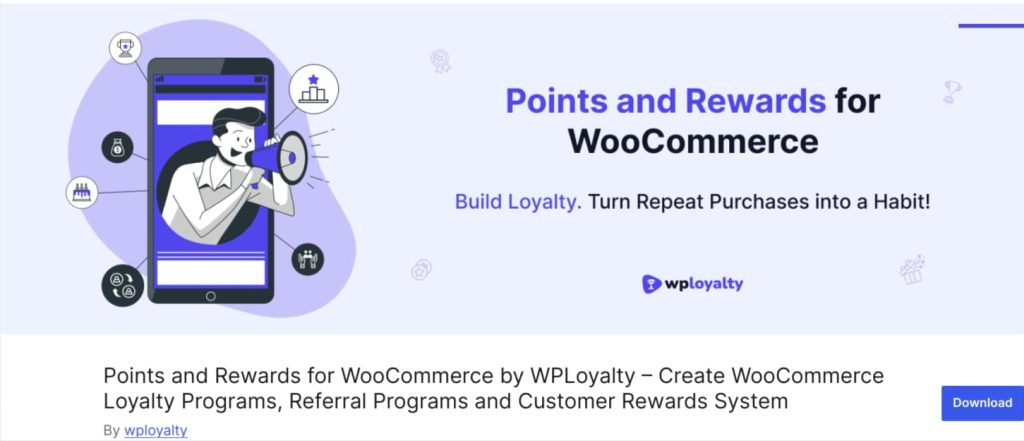
WPLoyalty is the best loyalty plugin for customers that offers a range of features for creating points-based, tiered, referral programs or even hybrid models.
It is specifically developed for WooCommerce stores. You will be able to create customizable loyalty programs for various customer actions like:
- Purchasing your products
- Referring new customers
- Writing product reviews
- Sharing via social media
- Signing up an account
- Sharing customer birthdays
- Logging-in daily
- Moving up level in tiers
The plugin comes with these flexible loyalty campaigns based on various conditions, such as customer groups, product categories, language, currency, order properties, and more.
It also provides options to schedule your campaigns in advance for special occasions and promotions. You can also set points and coupons expiration dates easily.
WPLoyalty has a clean and easy-to-understand dashboard to manage customers, along with their points, rewards, and smart coupons. Moreover, this loyalty plugin for WooCommere integrates seamlessly with your store.
key Features:
- You can set up loyalty campaigns for purchases, referrals, product reviews, and more.
- You can create tiered loyalty programs with exclusive rewards for each level.
- You can create a referral program and reward both new and existing customers.
- You can offer various rewards, including loyalty points, percentage discounts, Fixed discounts, free shipping, and free products.
- You have a guest referral add-on to instantly offer referral rewards to new customers.
- You can automate email notifications to keep your customers engaged.
- You have a detailed dashboard to track your program’s performance.
Pricing:
- WPLoyalty has a free version.
- Paid plan starts at $99/year.
- You also have a 14-day money back guarantee.
Set multiple rewards and campaigns for various customer actions using WPLoyalty’s customizable loyalty programs.
2. Bravo
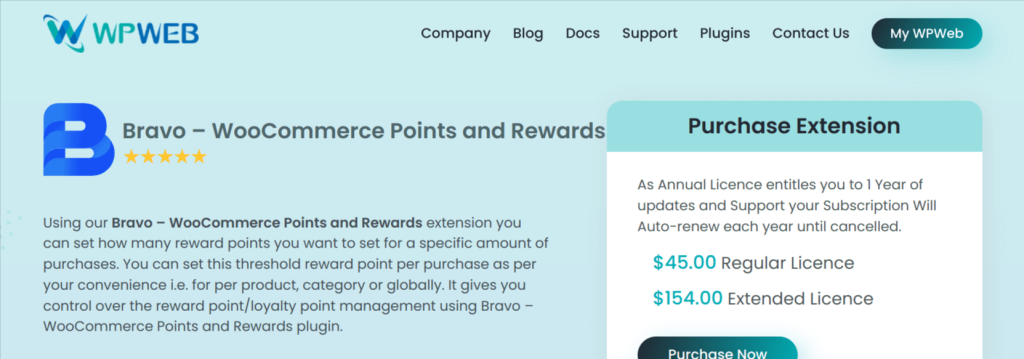
Bravo is a versatile loyalty points and rewards platform that gives you the features to build custom loyalty programs for various business types.
It lets you set how many points customers will earn for each dollar spent and set how many points can be redeemed for a specific discount amount.You have flexible control over reward points.
You can set the number of points earned per purchase at the product, category, or global level, and define the monetary value of each point. You can also manually adjust customer point balances as needed.
Key Features:
- Reward customers with points for purchases, sign-ups, and direct point purchases.
- Allow customers to redeem points for discounts based on a set conversion rate.
- Manage customer point balances manually, via import/export, and with bulk resets.
- Exclude specific products and users, and set minimum cart totals for points.
- Send automated emails about earned, redeemed, and expiring points.
Pricing
- No free version
- $45.00 Regular Licence
- $154.00 Extended Licence
3. Yithemes
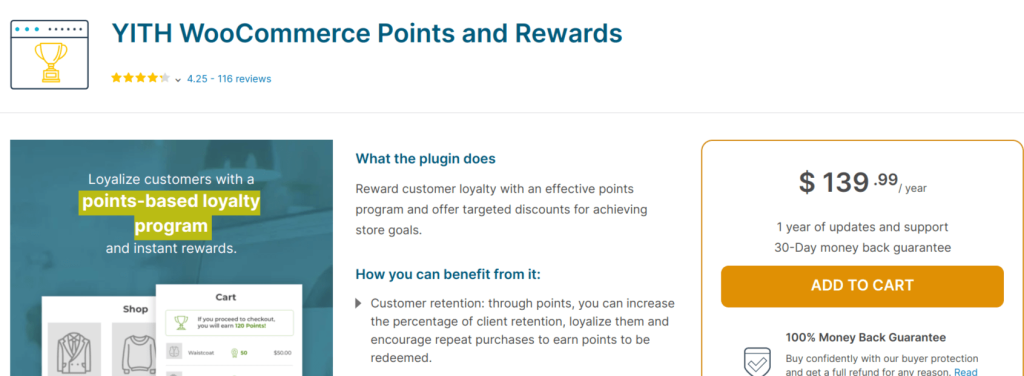
Yithemes WooCommerce Points and Rewards is a powerful plugin designed specifically for WooCommerce stores, giving you complete control over your points and rewards system.
This plugin makes it easy to assign points for various customer actions, such as making purchases, creating an account, writing product reviews, and more.
You can offer a wide variety of rewards. The plugin provides a user-friendly interface directly within your WooCommerce dashboard.
Key Features:
- You can assign points for purchases, sign-ups, reviews, and other actions.
- Use gamification by creating levels and badges.
- You can set up different exchange rates for points and rewards.
- Set conditions to redeem points based on the minimum cart value or set a maximum discount.
- You can offer various rewards, including discounts, free products, and free shipping.
- You can manage your program through a user-friendly interface
Pricing
- It has no free version
- Paid plan starts at $139/ year.
- You have 30-Day money back guarantee
4. WPswings
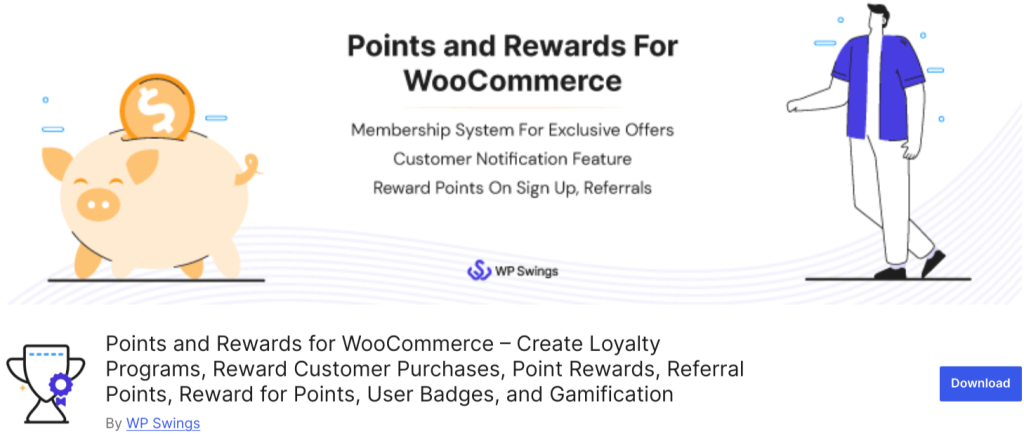
Points and Rewards for WooCommerce is a points management plugin to offer points on store activities like signup, purchase, referrals, etc.
You can also create tiered loyalty programs with escalating benefits to further incentivize customer engagement and drive repeat business.
WPSwings aims to provide you with all the necessary tools to build a comprehensive loyalty program that fits your specific needs.
Key features
- You can set up a points system to reward customers for purchases, referrals, reviews, social media shares, and other actions.
- You can offer a variety of rewards, including discounts (percentage or fixed), free shipping, free products, and exclusive offers.
- You can create a referral program to incentivize customer referrals and reward both the referrer and the referred customer.
- You can introduce gamified elements like leaderboards and challenges to boost customer engagement.
- You can send customized emails to customers for welcome messages, reward reminders, and promotional offers.
- You get access to analytics and reporting features to track key metrics
Pricing
- Free version available
- Paid plan starts at $99/year.
- You have 30 day money back guarantee
5. Gratisfaction
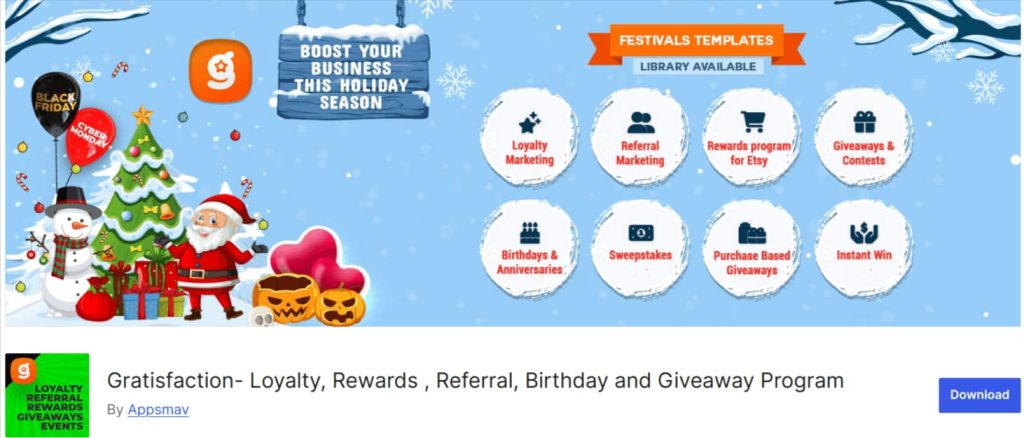
Gratisfaction is a loyalty plugin that helps you build loyalty, referral, and contest programs for your WooCommerce store.
It is designed to make it easy for you to reward customers for various actions, including purchases, referrals, social sharing, reviews, and more. You can set up points-based systems, run contests and sweepstakes, and create tiered loyalty programs.
The plugin likely offers features to customize the look and feel of your loyalty program to match your brand. It integrates easily with WooCommerce seamlessly for easy management.
Key Features
- Set up points for purchases, referrals, reviews, social shares, etc.
- Run contests, sweepstakes, and giveaways.
- Automated email notifications to engage customers.
- Social media integration for sharing and promotion.
- Activate multiple types of single or double sided referral programs.
Pricing
- Gratisfaction is free 100 users
- Paid plans are calculated based on the number of users you select.
Related reading: If you are looking for more detailed insights about points and rewards plugin check out our article on best WooCommerce Reward Points Plugins.
What are the Growing Trends in Customer Loyalty Programs?
Some growing eCommerce trends in customer loyalty programs include:
- Gamification: Use game elements (badges, points, challenges) to make earning rewards fun. Implement progress bars, leaderboards, or interactive challenges.
- Artificial Intelligence (AI): Analyze customer data with AI to predict needs and personalize offers. Use AI-powered recommendation engines and personalized messaging.
- Omnichannel Personalization: Personalize rewards across all customer touchpoints (online, in-store, mobile). Ensure consistent branding and reward systems across all channels.
- Experiential Rewards: Offer experiences (events, workshops, early access) beyond purchases. Host exclusive events, offer behind-the-scenes access, or create unique experiences.
- Dynamic Loyalty Tiers: Regularly adjust tiers based on customer engagement. Implement seasonal tiers, bonus point periods, or surprise tier upgrades.
- Sustainability and Green Loyalty: Incorporate eco-friendly actions into your program. Partner with environmental organizations, offer rewards for sustainable choices, or use eco-friendly packaging.
- Strategic Brand Partnerships: Partner with other brands for joint rewards and promotions. Offer cross-promotional discounts, bundled offers, or access to partner products/services.
- Mobile Wallet Integration: Offer rewards and access through mobile wallets. Integrate with Apple Pay, Google Pay, or other mobile wallet platforms.
- Advanced Program Automation: Automate tasks like points accrual and personalized messaging. Use marketing automation tools to trigger personalized emails and offers based on customer behavior.
Final Words
A successful customer loyalty program is essential for business growth. It’s not optional anymore. This guide has covered key aspects, from core components to program types and technology.
Remember, your program must resonate with your audience. It must align with your business goals. Start simple. Understand your customers. Choose the right program type. Offer real value through rewards.
Gather data. Learn what works. Optimize your program continuously. The future of loyalty is exciting. Personalization, gamification, and new technologies offer huge potential.
Other helpful resources you might like:
- Common Mistakes to Avoid When Crafting a Loyalty Program
- B2B Loyalty Programs: Complete Guide
- 8 Proven Customer Strategy Examples Every Brand Should Know
- 12 Winning Customer Acquisition Examples
- Best WordPress Loyalty Plugins
- How To Create A WordPress Referral Program?
- Best WordPress Referral Plugins
